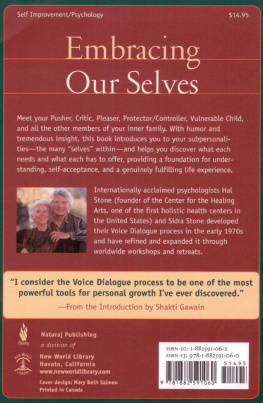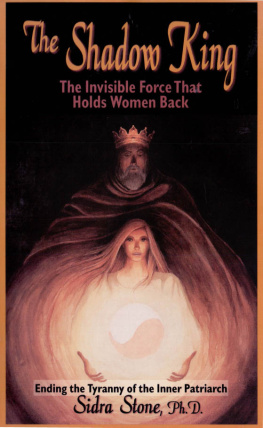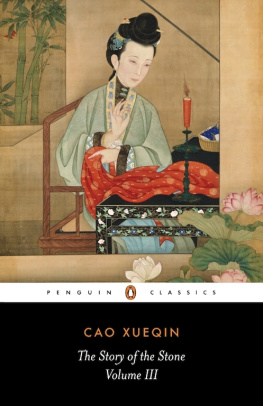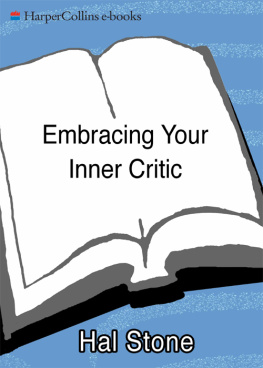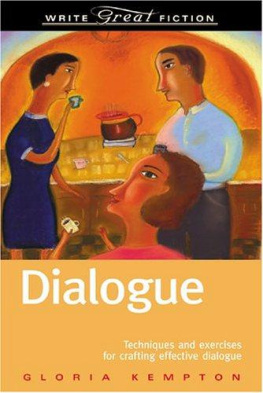
Embracing
Our Selves

The Voice Dialogue Manual
Hal Stone, Ph.D.
Sidra Stone, Ph.D.

New World Library
Novato, CA
Copyright 1989 Hal Stone and Sidra Stone
 | Nataraj Publishing a division of |
 | New World Library
14 Pamaron Way
Novato, CA 94949 |
Editorial collaborator: Kimberley Peterson
Production coordination: Merrill Peterson
Cover design: Kathleen Vande Kieft
Author photo: Sam Young
Text design: Abigail Johnston
Typography: Harrington-Young, Albany, CA
All rights reserved. This book may not be reproduced in whole or in part, without written permission from the publisher, except by a reviewer who may quote brief passages in a review; nor may any part of this book be reproduced, stored in a retrieval system, or transmitted in any form or by any means electronic, mechanical, photocopying, recording, or other, without written permission from the publisher.
The authors of this book do not dispense medical advice or prescribe the use of any technique as a form of treatment for physical or mental problems without the advice of a physician, either directly or indirectly. In the event you use any of the information in this book, neither the authors nor the publisher can assume any responsibility for your actions. The intent of the authors is only to offer information of a general nature to help you in your quest for personal growth.
This book was originally published as Embracing Our Selves: Voice Dialogue Manual, by De Vorss & Co., Marina Del Rey, CA, in 1985.
First Printing, January 1989
Printed in Canada on acid-free paper
ISBN 978-1-882591-06-0
Distributed to the trade by Publishers Group West
20 19 18
To
Belle and Herman Levi
and
Ethel and Sam Stone
Contents
There is a powerful, tingling sensation I feel throughout my body when I hear or read something that I know is profoundly true and important. I call that sensation my truth bell, and I experienced it quite dramatically the first time I read Hal and Sidra Stones material on the Voice Dialogue process.
A friend of mine had been seeing a therapist who used Voice Dialogue and had been telling me about it. She sent me a pamphlet written by Hal and Sidra describing Voice Dialogue and that is when my truth bell started ringing. I nearly devoured the pamphlet, excited because it touched on so many things that Id been discovering and experiencing.
The idea that we have many different voices or subpersonalities within us was not new to me. Since childhood I had been fascinated with the story The Three Faces of Eve, sensing, perhaps, that it had more relevance to all of us than we might realize. As an adult I had done considerable work with gestalt, transactional analysis, Jungian therapy, and other forms of consciousness work which involve the awareness of many different aspects within the self. But I had never seen or heard it described so clearly and accurately with such insight and understanding.
Eager to learn more, I read the first edition of this book, took an introductory seminar, and began using Voice Dialogue in my own personal process and in my work with others. The more I learned and worked with it, the more excited I felt. The process was fascinating and the results were powerful and dramatic.
Within a short time I met and got to know Hal and Sidra themselves. I have sometimes had the experience of reading a book that moved me deeply, subsequently meeting the author, and feeling somewhat disappointed that the personality did not seem to match the material that came through it. My experience with Hal and Sidra was the opposite. In person they match their material beautifullydown-to-earth and unassuming, intelligent and creative, deeply wise and loving. They have become dear friends and teachers to me and have strongly influenced my personal life and my work. I feel blessed to have them in my life, and Im excited about sharing their work with others.
I consider the Voice Dialogue process to be one of the most powerful tools for personal growth that Ive ever discovered. It has made a significant difference in my life and in the lives of many others I know. I feel that understanding and integrating this work can facilitate a major expansion of consciousness not only for each of us individually but for the entire planet as well.
With love,
Shakti Gawain
We are delighted that Shakti Gawain and Nataraj Publishing have enabled us to present you with this edition of Embracing Our Selves. Many years have passed since the original edition was published and during this period of time we have traveled and taught widely through the United States, Europe, Israel, and Australia. We have watched the Voice Dialogue process emerge around the world, often in places we have never been, taught by teachers that we have never met. This has certainly been a source of gratification for us, primarily because the real spirit of the work has thus far continued to be present during this emergence.
We have continued our own explorations with the Voice Dialogue process and some of our new thinking has been incorporated into this edition. In particular, we have found ourselves more and more interested in the role of the primary selves and their place in the overall development of personality. In our clinical work, we now spend much more time working with the primary selves. We feel it is important for each of us to develop a complete understanding of, and a real appreciation for, the primary selves and how they have operated in each of our lives. Thus you will find here a new emphasis on the role of these selves. We have also added sections on the complementary energies of personal/ impersonal and being/doing because these, too, have proven very useful.
As we have become more aware of the impact of this work, we have increasingly realized that certain safeguards should be kept in mind when using it. Therefore, we have expanded the section on safeguards in the Voice Dialogue process and we suggest that you read it carefully. Above all, please be aware that Voice Dialogue is a communications tool as well as a method that can be used for getting to know ourselves better. It is neither a psychotherapeutic system nor a substitute for appropriate psychotherapy when this is indicated.
In our travels, teachings, and writings we have steadfastly refused to provide any kind of certification process for training in Voice Dialogue. There is no such thing as a Voice Dialogue therapy. It is impossible to separate Voice Dialogue from an understanding of dream work, symbolic visualization, a knowledge of energetics, training in interpersonal processes, or a multitude of other approaches to understanding the evolution of consciousness. The richer the background of the facilitator in all of these approaches, the richer will be the quality of facilitation. This is one of the reasons why the Voice Dialogue process can be integrated into any theoretical approach or any way of working with issues of personal growth. It supplements and enriches them rather than polarizing against them. It is for this reason that you will find the work being used by an amazingly wide range of therapists, consciousness teachers, and nonprofessionals of different orientations.
Next page
